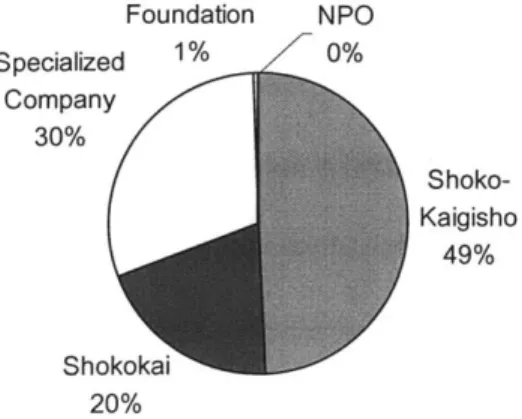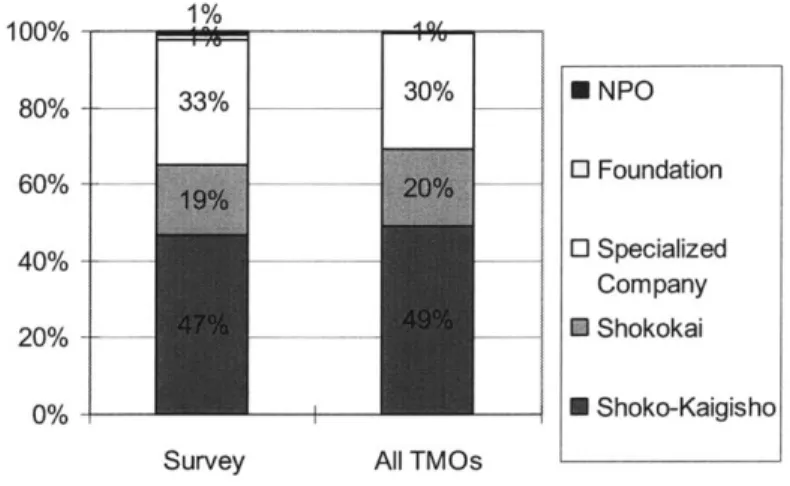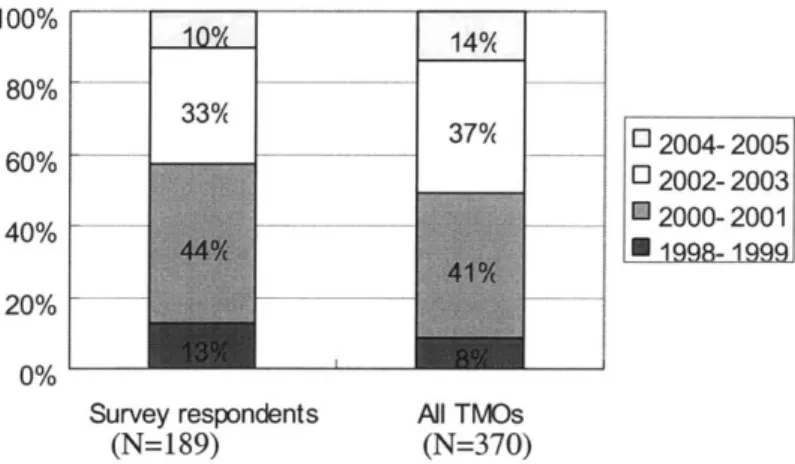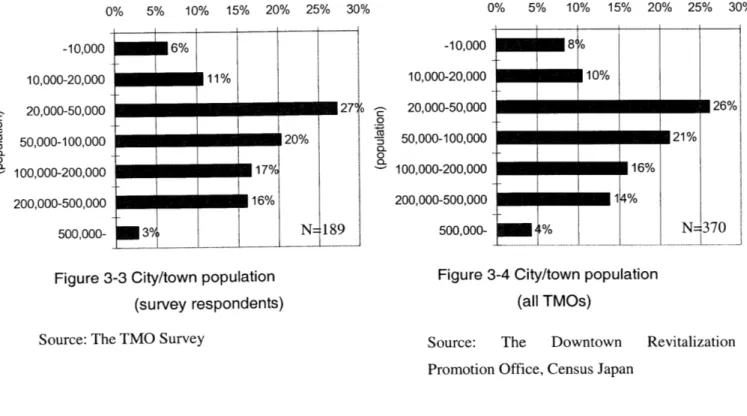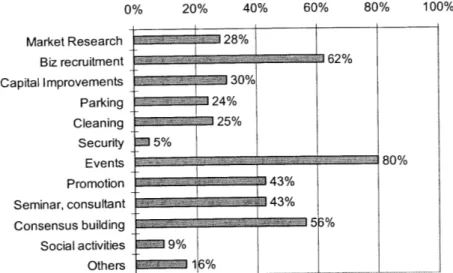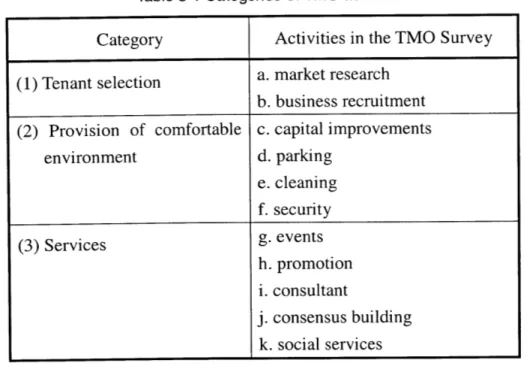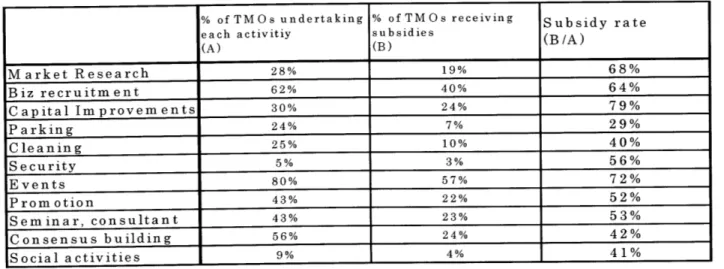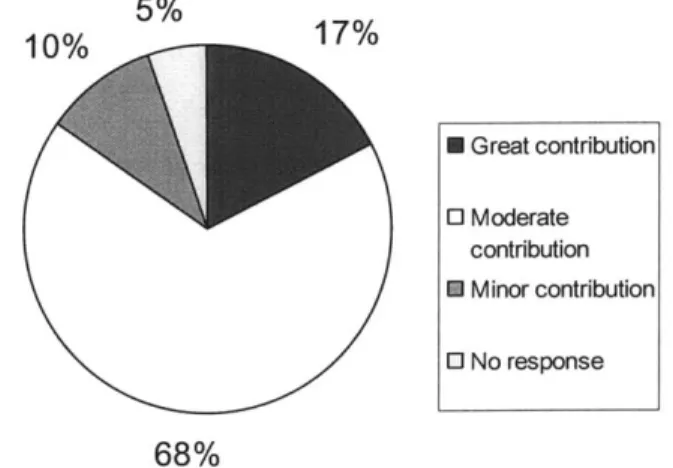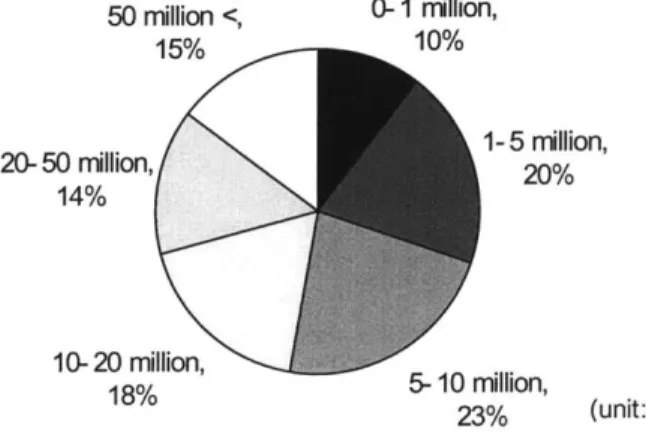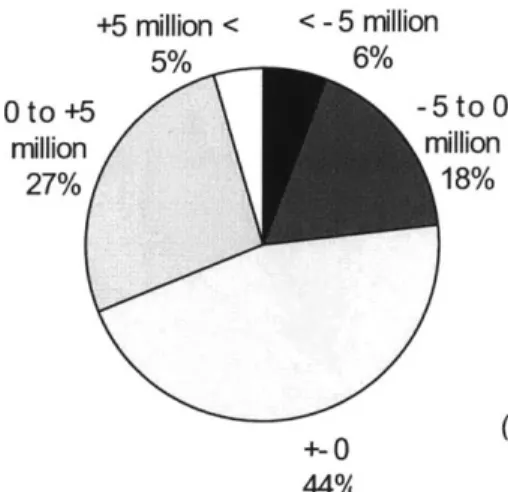Downtown Revitalization in Japan:
Examination of the Town Management Organization Model By
Masatomo Miyazawa Bachelor of Law University of Tokyo (2001)
Submitted to the Department of Urban Studies and Planning in partial fulfillment of the requirements for the degree of
Master in City Planning at the
MASSACHUSETTS INSTITUTE OF TECHNOLOGY June 2006
9 2006 Masatomo Miyazawa. All Rights Reserved MASSACHUSETTS INTIU OF TECHNOLOGY
The author hereby grants to MIT penilesion to reproduce and to
distribute publicly paper and electronic copies of this thesis docutam t
OiC
26
2006 in whole or in part in any medium now known or hereafter created.LIBRARIES
Author
I6epartment of Urban Studies and Planning May 17, 2006
Certified by _
Karl Seidman Department of Urban Studies and Planning Thesis Supervisor
Accepted by
0 > u Professor Langley Keyes Chair, MCP Committee Department of Urban Studies and Planning
Downtown Revitalization in Japan:
Examination of the Town Management Organization Model
By Masatomo Miyazawa
Submitted to the Department of Urban Studies and Planning on May 17 in Partial Fulfillment of the Requirements
for the Degree of Master in City Planning
ABSTRACT
Downtowns have experienced decline since the 1990s in Japan and several strategies have been implemented to deal with it. This research focuses on one of such strategies-the Town Management Organization (TMO) model. Although the model was expected to achieve downtown revitalization through managing downtown areas, it has made negligible contributions. This research examines the reasons why the TMO model has not worked well through a survey and interviews with TMO staff members.
This research demonstrates that TMOs tend to face obstacles at two different stages, which has led to the low level of contribution of the TMO model. At the planning stage, most TMO boards are dominated by commercial stakeholders and do not take in broad opinions. As a result, most TMOs do not gain benefits from active participation of various local stakeholders or receive their political and financial support. At the implementation stage, TMOs face different difficulties according to their funding structure. TMOs raising their funds mainly from such outside sources as subsidies tend to face funding shortages and lack of staff, and as a result, do not conduct effective revitalization activities. In contrast, TMOs that are not dependent on outside sources but make most earnings from the sales of goods or services are likely to face deficits and focus on profitable activities which might not be related to downtown revitalization.
This research recommends that TMOs reform their boards, capitalize on external conditions, diversify their funding sources, and utilize other resources such as volunteers and financial institutions. In addition, this research proposes that governments create effective public policies to help TMOs carry out these recommendations.
Thesis Supervisor: Karl Seidman
Acknowledgements
I especially appreciate the sincere support and encouragement of my academic and thesis advisor, Karl Seidman, Senior Lecturer at the Department of Urban Studies and Planning, along with the wealth of insightful suggestions he gave me during the past two years. Without his help, my thesis work could not have been completed.
I would like to thank my thesis reader, Professor Diane Davis, for her advice and support. I would also like to express my gratitude to Robert Doherty for helping me improve my writing
style.
I wish to thank Minami Tsubouchi, my classmate. Discussions with her have encouraged me to think about a variety of issues in the world.
My graduate study at MIT was achieved as a result of the full support of the Japanese Government, and I wish to express my heartfelt appreciation to the Japanese Government for giving me this great opportunity.
And finally, last but not least, I would like to give special thanks to my wife Eriko, and my son Junsei. Their cooperation and kind assistance allowed me to complete my studies and added greatly to these two memorable years at MIT.
Contents
Chapter 1: Introduction...9
Chapter 2: Decline of Downtowns and Town Management Organization...16
2-1 Downtown Decline and Policy Responses...16
2-2 Basic Information about Town Management Organization...27
2-3 Current Issues Related to the TMO...30
2-4 C onclusions... 33
Chapter 3: Overview of Activities and Problems of TMOs...34
3-1 The Survey Respondents...34
3-2 A ctivities of T M O s...38
3-3 Issues facing TMOs...43
3-4 C onclusions...51
Chapter 4: Differences among TMOs...54
4-1 Classification of TMOs...54
4-2 Differences in structure by type ... 57
4-3 Differences in function by type...72
4-4 Issues facing each type of TMO...75
Chapter 5: Effects of External Contexts...79
5-1 External contexts and funding sources...79
5-2 External contexts and differences among each type ... 82
5-3 Four examples of Successful TMOs...87
5-4 Current changes of TMOs in small and large cities...94
5-5 C onclusion s...10 1 Chapter 6: Conclusions and Recommendations...102
6-1 The reasons why the TMO model has not worked...102
6-2 R ecom m endations...107
Bibliography...115
Tables
Table 3-1 Categories of TMO activities...40
Table 3-2 Percentages of TMOs that receive subsidies in conducting each activity...41
Table 3-3 Number of board members in an average TMO by stakeholder group...48
Table 4-1 Three types of TM O s... 57
Table 4-2 Summary of differences in structures among the three types...59
Table 4-3 Number of board members in an average TMO by stakeholder group by type...61
Table 4-4 Median number of staff members in each type...69
Table 4-5 Voluntary participation in each type...71
Table 4-6 Summary of differences in function among the three types...72
Table 4-7 Activities of TMOs in each type...73
Table 5-1 Summary of similarities and differences by types and city size...83
Table 5-2 Number of board members in an average TMO by stakeholder group (Type 1)...84
Table 5-3 Number of board members in an average TMO by stakeholder group (Type 3)...84
Table 5-4 Median expense in Type 1 and Type 3 TMOs by city size...85
Figures
Figure 1-1 Thesis framework...15
Figure 2-1 Organizational type...29
Figure 3-1 Organizational type (survey respondents and all TMOs)...35
Figure 3-2 Establishment year (survey respondents and all TMOs)...36
Figure 3-3 City/town population (survey respondents)...37
Figure 3-4 City/town population (all TMOs)...37
Figure 3-5 Activities of TMOs... 39
Figure 3-6 Contribution of TMOs...42
Figure 3-7 Annual expenses of TMOs...43
Figure 3-8 Annual profits/deficits of TMOs...44
Figure 3-9 Funding source... 45
Figure 3-10 Composition of revenue in an average TMO...45
Figure 3-11 Percentages of TMOs with board members from different stakeholders...48
Figure 3-12 Frequency of board meetings per year...48
Figure 3-13 Percentages of TMOs that inform biz owners/residents of its activities...50
Figure 3-14 Percentages of TMOs with voluntary participation of biz owners/residents...50
Figure 3-15 Number of full-time staff...51
Figure 3-16 Number of full- and part-time staff...51
Figure 3-17 Overview of activities and problems of TMOs...53
Figure 4-1 Dependency on outside sources... 57
Figure 4-3 Frequency of board meetings in each type (per year)... ... 62
Figure 4-4 Annual expenses in each type...63
Figure 4-5 Annual profit/deficit in each type...68
Figure 4-6 Number of full-time staff in each type...69
Figure 4-7 Number of part-time staff in each type...69
Figure 4-8 Summary of differences in issues...77
Figure 5-1 Population of cities/towns in each type...80
Figure 5-2 Current changes of TMOs in small cities...95
Figure 5-3 Current changes of TMOs in large cities...99
Chapter 1: Introduction
Although downtowns used to be the center of residential, economic, and cultural life, many cities and towns in Japan have experienced suburbanization and downtown decline since the 1990s.1 Residents have moved toward suburban areas, accompanied with decentralization of businesses. Retail stores in downtowns have found it difficult to compete with suburban large-scale stores. The number of pedestrians and visitors has decreased in downtowns, whereas vacancy rates have
2
increased. Many abandoned properties can be found in downtowns, especially in rural small cities. Commercial streets in some downtowns are called "shutter streets" because many stores
along the streets close the shutters. Such a situation is considered a big problem.
Suburbanization and downtown decline occurred much earlier in the United States than in Japan. As wealthier people and businesses left downtowns for suburban areas since the 1950s, downtown areas have faced several problems, such as the concentration of low-income residents, the increase in crime, physical decay, and decrease of the tax base.3 In order to solve these problems, a variety of downtown revitalization strategies have been implemented, one of which is the Business Improve District (BID). BIDs have been established all over the United States since the 1970s, and there are 404 BIDs according to Jerry Mitchell.4 BIDs are regarded as important contributors to downtown revitalization.5
Borrowing the idea of the BID, the Japanese government introduced in 1998 a new model,
For the purpose of this study, downtown refers to the area playing the role as the center of a city or town. The
Japanese equivalent of downtown is Chuushin Shigaichi, which literally means a central urban area.
2 Ministry of Land, Infrastructure and Transport (MLIT), Report of Boardfor Downtown Revitalization: 2-6
3 Burayidi, Michael A (Ed), Downtowns: Revitalizing the Centers of Small Urban Communities, (New York,
NY: Routledge, 2001), 1-5.
4 Mitchell, Jerry, Business Improvement Districts and Innovative Service Delivery (New York: The PricewaterhouseCoopers Endowment for the Business of Government, 1999);
5 Briffault, Richard, "A Government for Our Time? Business Improvement Districts and Urban Governance."
the Town Management Organization (TMO), in order to revitalize downtown areas. The TMO model copies the centralized management of shopping malls: TMOs are expected to contribute to downtown revitalization through the management of these areas. In only eight years since the adoption of the TMO model, 375 TMOs have been established all over the nation.6 Although some TMOs have succeeded in stopping downtown declines, most of them made negligible contributions to downtown revitalization and many downtowns are still declining.7
Research Questions
This research focuses on the TMO model among many strategies that have been implemented for downtown revitalization, such as urban redevelopment and business attraction programs. Unlike in the United States where many types of organizations, such as BIDs and Main Streets, work for downtown revitalization, there are a small number of such organizations in Japan. TMOs are almost the first organization focusing their work on downtown revitalization, and so it has been expected that the establishment of TMOs would create positive impacts on downtowns. Because some TMOs have contributed to revitalizing downtowns, there is a great potential that TMOs can become contributors for downtown revitalization, which is why this research focuses on the TMO model.
Against the expectation, the fact is that most TMOs have found difficulty in undertaking effective activities and have made tiny contributions to downtowns. In other words, although there is a high potential that TMOs could contribute to revitalizing downtowns, as shown in
some success cases, some obstacles have prevented most TMOs from having success. Considering that TMOs face obstacles everywhere in Japan, the problem is not a specific 6 This number is based on the data gathered by the Japanese government as of May 15, 2005. The number may have grown since then.
7 Saitou, Go, and Susumu Hatano, City Planning based on TMO (2001).
characteristic of only a few TMOs, but a structural problem of the TMO model. The purpose of this research is to analyze why TMOs have not necessarily worked well in spite of their potential for success.
Many researchers, government officials, and TMO staff believe that several factors have contributed to the low level of contribution of TMOs. The most cited reason is that many TMOs face financial difficulty and so cannot play the intended management role. In fact, many TMOs have asked for financial aid in a public hearing or surveys, and furthermore, a TMO has gone bankrupt. In addition to the funding problem, other factors, such as the low level of collaboration with local stakeholders and the lack of TMO staff, are also regarded as contributory factors. Based on these existing findings, this study focuses on answering the following research questions:
" To what extent do TMOs face the three problems-funding problem, low level collaboration with local stakeholders, and lack of staff? What is the nature of the difficulties?
" Why do they face these problems?
" How do these problems relate to one another?
e How do these problems affect the level of contribution of TMOs to downtown
revitalization?
By answering these questions, this study would help to understand why so many TMOs have not contributed to downtown revitalization. The results of this study would be useful for governments in making better policies for the TMO. In particular, it could be useful for the central government, which is now modifying the TMO model. In addition, existing TMOs could use it to improve their activities, and people who are working for downtown revitalization could also utilize it for making effective strategies.
Methodology
The study methodology consists of three components: a review of existing literature, a survey of TMOs (TMO Survey), and qualitative interviews with TMO managers and staff.
Although existing literature provides basic insight into TMOs, it is insufficient to answer the research questions completely: there is little literature that analyzes the nature of the three problems, how these problems are interrelated, and how they affect TMO activities. In addition, there is almost no research that analyzes the TMO model by focusing on differences among TMOs. On the one hand, some researchers analyze at the macro level and treat all TMOs as if they had the same problems to the same degree and ignore differences among TMOs. On the other hand, some researchers analyze TMOs at the micro level and focus on individual TMOs and do not make comparisons. In order to answer the research questions, this research conducts the TMO Survey to make analyses at the macro level and to explore differences among TMOs and factors creating the differences.
The TMO Survey was carried out by mail in January 2006 to 370 TMOs in Japan. Each TMO staff received an envelope containing a cover letter, survey, and postage-paid reply envelop. In addition, the TMOs that did not return the survey received reminders in the form of e-mails. Surveys were received from 189 TMOs, and the response rate was 51%.
The list of TMOs to be surveyed was developed from the website of the Downtown Revitalization Promotion Office, the Japanese Government, where 375 TMOs were found. Five out of them were listed twice because they were in charge of two different districts. These five TMOs were counted only once in this survey, which is why the survey was sent to 370 TMOs rather than 375.
The survey was written in Japanese and includes 13 questions. Many of the questions were 12
in multiple-choice or closed-ended format, in which TMOs were asked to provide such information as organizational type, the year of the establishment, the number of staff, their board members, their budget, and their activities. Also, the survey contained one question that allowed open-ended answers, in which TMOs were asked how their funding systems affected their
activities. The survey instrument can be found in the Appendix with an English translation. In order to complement the survey, six telephone interviews were conducted with TMO managers and staff. Each contact person received a questionnaire by e-mail ahead of the interview, and notes were recorded during the interview. In addition, additional data was gathered through several e-mail exchanges with TMO managers and staff.
Thesis Framework
Figure 1-1 illustrates the framework of this research. The introductory chapter gives an overview of the research, demonstrating the research questions and methodology. Chapter 2 shows the background of the TMO model. Specifically, the chapter illustrates the reasons for downtown decline and policy responses in Japan, details of the TMO model, and issues facing TMOs. Because the TMO model was established in imitation of the U.S. BID model, downtown decline and policy responses in the United States are also discussed in this chapter.
Chapter 3 presents an overview on TMOs from the macro point of view. Specifically, this chapter clarifies what kind of activities TMOs are conducting, what problems they are experiencing, and to what extent they are facing these problems. Through these analyses, this chapter presents that TMOs face obstacles at both planning stage and implementation stage in general.
The next two chapters make analyses in depth, focusing on differences among TMOs. Considering that each TMO differs from one another, issues should vary among TMOs.
Therefore, the investigation of differences in issues among TMOs helps understand more on why the TMO model has not worked. In Chapter 4, TMOs are divided into three categories, based on the degree of self-dependency. The findings suggest that all TMOs, regardless of the degree of self-dependency, tend to have similar difficulties at the planning stage, whereas TMOs with high level of self-dependency experience completely different difficulties from those with low level of self-dependency at the implementation stage.
Chapter 5 explores the effects of external contexts. TMOs cannot be irrelevant to surrounding environments. Specifically, city or town size is one important factor that determines the nature of TMOs: TMOs in large cities should be different from those in small towns. This chapter investigates how the city/town size creates differences in obstacles facing TMOs. In addition, this chapter demonstrates under what conditions TMOs are likely to contribute to downtown revitalization through the examination of four examples of successful TMOs.
Based on these findings, the final chapter discusses implications and recommendations for governments and TMO staff.
Introduction
Bacekg~ronund---
--
N C h a p te r
1
I
-+
Chapter 2I
Analyses
Analyses of TMOs as awhole
Analyses of differences
-among TMOs by funding structure
--- Analyses of the effects of external contexts External contexts (City/town size)
-o
Chapter 3I
-+
Chapter 4
+~ Chapter 5
Conclusions
" Summary of the analyses " Recommendations
Figure 1-1 Thesis framework Source: Author
. Causes of downtown decline
" Policy responses " TMO model
e Issues facing TMOs
.l
Chapter 2: Decline of Downtowns and Town Management Organization
In the United States, people and businesses that once contributed to the prosperity in downtowns have moved to the surrounding suburbs, resulting in the decline of these areas.8 Similarly, in Japan, downtowns have experienced a steady decline: they have lost their population, retail stores, and offices.9 In order to stop the continuing decline of downtowns, several strategies have been implemented in both countries. One of them is the Business Improvement District (BID) in the United States and the Town Management Organization (TMO) in Japan.
In this chapter, I provide an overview of what has happened in downtowns, based on the existing research and literature. I first demonstrate the causes of the decline and the policy responses in Japan as well as in the United States. Second, I explain the details of the TMO model. Finally, I present current issues about the TMO model.
2-1 Downtown Decline and Policy Responses
Downtown Decline in the United States
Causes of Downtown Decline
Downtown areas started declining in the 1920s and the speed of the decline increased after World War Two in the United States.10 Several reasons have been given for this decline. First,
middle-class people moved to the suburbs in search of more space, inexpensive housing, and a
8 Burayidi, 1-5.
9 Ministry of Internal Affairs and Communications (MIC), Recommendation Based on Public Evaluation
about Downtown Revitalization (2004).
lower cost of life, which caused a decrease in population and demographic change in centered cities." What boosted this movement were the Federal government policies that favored suburbs, such as the Federal Housing Redevelopment Acts of 1949 and 1954 and the Federal-Aid Highway Act of 1956. These programs offered homeownership subsidies for the middle class and stimulated the construction of highways in the suburbs, which made life in suburban areas more affordable and convenient and encouraged the movement of people to suburbs.' In addition, changes in the transportation technology fueled this movement. That is, although downtowns used to be prosperous due to the easy access via such mass transit as street cars, they were inconvenient for automobiles because of narrow roads and few parking spaces. Therefore, the increase in automobiles lowered the advantage of downtowns and heightened the importance of suburbs where land is abundant.13 Whereas middle-class people moved to the suburbs because of these factors, low-income residents remained and concentrated near downtowns. Exclusionary zoning laws prevented the development of low-income housing in suburban areas by setting a minimum lot size, which made it difficult for low-income people to move from centered cities.'4
Another major factor of the downtown decline was the decentralization of retail stores. Due to the movement of people to the suburbs, retail stores in downtowns lost their customers and so started to follow them to the suburbs. Furthermore, the emergence of shopping malls and large discounters, such as Wal-mart, which tended to locate in suburbs because they need large spaces, created considerable negative effects on small retail stores in downtowns.' 5
" Gottdiener, Mark, Planned Sprawl: Private and Public Interests in Suburbia (Beverly Hills: Sage
Publications, 1977), 13 12 Burayidi, 1; Gottdiener, 15.
13 Fogelson, Robert M, Downtown: Its Rise and Fall, 1880-1950 (New Haven, CT: Yale University Press, 2001), 222.
14 Gottdiener, 50-58
Third, business decentralization and the decrease in job opportunities in downtowns also led to the decline. Firms have been attracted to suburban areas because they could develop sites more cheaply and easily than in downtown: it is time-consuming and costly for firms to develop sites in downtown where lands are not only expensive but also divided among several owners.,6 Moreover, the shift from the manufacturing-dominated economy to the service economy made it more difficult for lower-skilled workers, who used to work for manufacturing firms in downtowns, to get well-paying jobs."
Policy Responses
Suburbanization and downtown decline created several problems in the United States. First, because businesses moved towards suburban areas, low-income residents, who could not obtain houses in the suburbs and remained in urban cities, found it difficult to get stable and well-paid jobs in their neighborhoods. They had to commute to work in suburbs, have low-paid jobs, or become unemployed. 18 Second, as businesses and middle- or working-class people left downtowns towards suburban areas, local governments administering downtowns experienced loss in tax revenues, which restrained the governments' budgets. This fiscal limitation lowered the level of public services, which contributed to worsening the quality of life in downtowns.'9 Third, local governments where new development was conducted were required to provide infrastructure amenities, such as police, education, and roads, leading to an increase in expenditures and a high tax rate.2 0
In order to deal with these problems, a variety of policies have been implemented to
16 Burayidi, 1.
17 Zielenbach, Sean, The Art of Revitalization: Improving Conditions in Distressed Inner-city Neighborhoods
(New York, NY: Garland Publishing, 2000), 55-83.
18 Burayidi, 1-2. 19 Ibid.
revitalize downtowns, and local governments (state and municipal governments) have taken an important part. In the United States, the governmental system-federalism-gives large powers to local governments. In addition, fiscal deficits of the federal government and national political obsession with avoiding taxes have further prevented the federal government from providing substantial financial support to downtown revitalization.2 According to Frieden, the federal
22
government phased out urban aid programs. Thus, although the federal government has established several policies for downtown revitalization, local governments have also played a key role in developing these policies.
Policies related to downtown revitalization can be divided into three categories. The first type is the redevelopment of downtowns. Suburbanization has created abandoned or blighted properties in downtown areas. Also, rapid economic growth in suburban areas has made it difficult for downtowns to compete with suburbs. In order to renew these properties and support new economic activities in downtowns, redevelopment agencies that represent local governments have been established in many states and cities.23 These public agencies have encouraged large-scale private projects by assembling lands, demolishing existing structures, and giving financial support. They have also improved infrastructures for stimulating private investments. Although the federal government has also encouraged urban redevelopment through such program as the Urban Development Action Grant Program, local development agencies have
strongly stimulated redevelopment.
The second type is business attraction and development. As mentioned above, businesses in downtowns have faced severe competition with suburban businesses, which resulted in the
21 Bartik, Timothy J, What Should the Federal Government Be Doing About Urban Economic Development?
(1994).
22 Frieden, Bernard. J, Center City Transformed, Journal of American Planning Association (1990 Autumn).
decrease in businesses and job opportunities in downtown areas. In order to support the growth of businesses, many cities have implemented policies for business development. One example is business incubation programs, which provide start-up businesses with professional services and space at below-market rate. Business incubators have increased in number since the 1980s, and
24
there are more than 500 in North America.
The third approach for downtown revitalization is district management. This approach is intended to overcome one big disadvantage of downtown-fragmentation of the local stakeholders: they rarely work together for the improvement of downtown areas without effective organizations. This approach tries to manage and coordinate the actions of the stakeholders so that downtowns can successfully compete with suburbs. One example of this is the Main Street program, which was introduced by the National Trust for Historic Preservation in the 1970s. This program uses a four-point approach for downtown revitalization-organization,
promotion, design, and economic restructuring-, and aims at revitalization through community-based and incremental efforts, based on consensus and cooperation among the
25
various stakeholders. Because the Main Street program is a comprehensive approach that could be tailored to meet local needs, and because the National Main Street Center established a network of resources for information, training, and technical assistance, the program has been widespread: about 1,600 communities have used it for downtown revitalization in the United States.26
Another example of the district management is the BID. The BID is defined as an approach in which "a geographically defined majority of property owners and/or merchants agrees to
2 Resser, Thomas, "Business Incubators," The Inner City: A Handbookfor Renewal, Ed. Roger L. Kemp
(Jefferson, NC: McFarland & Company, 2001): 124-129.
25 National Trust for Historic Preservation website.
26 Seidman, Karl, Revitalizing Commercial for American Cities: A Practitioner's Guide to Urban Main Street
Programs (Washington, DC: Fannie Mae Foundation. 2004), 3-6. 20
provide an extra level of public service in a specific area by imposing an added tax or fee on all
27
of the properties and/or businesses in the area," according to Jerry Mitchell. Examples of these services are supplementary security, additional street cleaning, and the unique marketing of events. Thus, BIDs share the cost of common area maintenance and manage the district. The authorization of BIDs is provided by state laws, and the job of local (municipal) governments is to legally establish BIDs, collect the special tax assessments, and transfer the funds over to BIDs. BIDs began to be established in the 1970s, and increased in number rapidly in the 1990s: there are more than 400 BIDs in the United States.28
Downtown Decline in Japan
Causes of Downtown Decline
Decentralization of businesses and residents occurred much later in Japan than in the United States: downtown decline became recognized as a big problem in Japan in the 1990s.2 9 There are two major factors that contributed to the downtown decline. The first was the movement of people to suburbs, which has been caused partly by a significant increase in land prices. In the late 1980s, land prices soared dramatically as a result of the bubble economy: for example, the land price in six large cities rose by 200% from 1985 to 1990. The rise was considerable especially in downtown areas.3 0 Although the bubble burst in the early 1990s, the land price in
downtowns have remained higher compared to that in suburbs.31 Thus, high land values have prevented people from living within and near downtowns and encouraged decentralization of
27 Mitchell, 6-13. 28 Ibid.
29 Yasui, Miki. "Business Improvement Districts (BID): the United States and Japan." Toshi Keikaku 242
(2003): 47-50.
30 Japan Real Estate Institute, Urban Land Price Index.
31 Tsuruta, Tetsuya, "Possibility of downtown revitalization by TMO." UFJ Institute Report 2003.3 Vol8 No.
residences. In addition, an increase in automobiles has fueled the decentralization of the population. That is, as in the United States, increasing cars lowered the attractiveness of downtown areas that used to be the center of mass transit and enabled people to live in suburbs conveniently. The popularization of automobiles occurred in Japan much later than in the United States: whereas one out of five people had an automobile in the 1930s in the United States, it was as late as around 1980 when one out of five people had a car in Japan.3 2 Since then, automobiles have increased in number, which has encouraged people to locate in suburbs instead of downtowns.
Second, businesses also moved to suburban areas, and downtowns have lost the position as a commercial center. The rise in the land prices and the increase in automobiles have also encouraged retail stores and even public facilities, such as city halls, to move to suburbs.3 3 Furthermore, downtown retail stores have experienced severe attacks from large retail stores and shopping centers in suburban areas, which were established due to the deregulation in the early 1990s. That is, the establishment of large stores was strictly controlled by the Large-Scale Retail Store Law until 1990: under the law, those who would like to open new large stores were required to agree with existing business owners in the neighborhoods about the construction of the large stores.3 4 Because local business owners usually disagreed with the construction to
protect their profits, it sometimes took ten years to be allowed to open large retail stores, which restrained the increase in large stores.35 However, such a strict regulation was criticized by not only Japanese economic world but also the U.S. government, and as a result, the central government eased the regulation in 1990, which caused a dramatic increase in international and
32 Kaidou, Kiyonobu, Compact City (Kyoto, Japan: Gakugei Publisher, 2001), 194-195
33 Hosono, Sukehiro, Smart Community, (Tokyo, Japan: Chuou University Press, 2000), 161. 3 Hosono, 258-263
35 Sato, Toshihiko, "What the Large-Scale Retail Store Law Brought About." SRIC Report 2001.3 Vol. 6 No. 2: 4-14.
national large retail stores: the establishment of large stores increased in number by 100% from 1989 to 1990. These stores tended to locate in suburbs where cheap land is widely available, contributing to the reduction of the sales of stores in downtowns.
Thus, on the one hand, downtown decline in Japan is similar to that in the United States in several points. In both countries, the increase in automobiles has decreased the importance of downtown areas, which has contributed to the decentralization of people and businesses. In addition, the emergence of large stores in suburban areas has threatened retail stores in downtown areas, which has fueled the decline of downtowns. On the other hand, there are differences between these two countries, too. The concentration of low-income residents near downtowns, which can be found in the United States, is not recognized as a big issue in Japan. Also, because the popularization of automobiles and the increase in large stores occurred in Japan much later than in the United States, the decentralization and downtown decline had not occurred until the 1990s in Japan.
Problems caused by downtown decline
Downtown decline has become a big issue in Japan. The out-migration of the population and businesses has contributed to an increase in vacancy rates in downtowns. In particular, the movement of large retail stores to suburban areas has brought about extremely negative effects on downtowns. These stores had been a destination and attracted many people to downtown areas, and therefore, the relocation of these stores reduced the attractiveness of downtown areas considerably.36 Because of a weak investment climate in downtowns, these properties are typically kept abandoned: only 37% of such properties are reoccupied by other tenants.37
36 MLIT (2006), 5-6
3 Ministry of Economy, Trade and Industry (METI) (2005)
The situation is much worse in small cities, especially in rural areas, than in large urban cities.3 8 First, the fact that suburban areas of small rural cities are typically composed of
farmlands leads to a significant decline in downtowns. That is, because there is almost no regulation on the usage of farmlands, large-scale developments can be easily conducted in the farmlands.39 As a result, many large stores have been constructed on these farmlands in suburbs without any constraints, which have worsened the situation of downtowns in these cities. Second, people have become highly dependent on automobiles in small rural cities, contributing to a decrease in the importance of downtowns.40 Unlike in large urban cities, public transportation is not convenient in these cities: because of the small population, following by the small demands for public transportation, trains or buses run infrequently. As a result, the degree of reliance on automobiles has increased largely in small rural cities, encouraging residents to drive to stores in suburban areas where parking is abundant.
Not only business owners in downtown areas but also many other local stakeholders are concerned about downtown decline. First, some residents who do not drive a car and have visited stores in downtowns using pubic transportation express complaints on downtown decline. Because it is not necessarily easy for them to go shopping in suburban areas, the decrease in number of stores in downtown areas means a reduction in shopping opportunities for them. Considering that aging population is increasing dramatically, it is projected that the number of
41
people with limited shopping opportunities will increase. Second, local governments also want to stop downtown decline and suburbanization. New developments in suburban areas have required local governments to offer further infrastructure, which has imposed heavy burdens on
38 Motoyama and Okada, Size of Local Governments and Their Capacity.
39 MLIT (2006), 19-20
40 MLIT, Report for Advisory Meeting on Downtown Revitalization, 2005.
them. To make matters worse, National Institute of Population and Social Security Research has forecasted that the Japanese population will decrease dramatically because of a declining birthrate: the population is projected to decrease by 1.5 million from 2005 to 2015 and by further
42
5 million from 2015 to 2025. Because the decrease of population will lead to a drop in tax revenue, downtown decline and sprawl, followed by the provision of new infrastructure, is
expected to cause serious damages to government budgets.43
Policy Responses
In order to deal with downtown decline, many policies have been implemented. One characteristic of these policies in Japan is that the central government has played a key role. Unlike in the United States where federalism is adopted, the government has been centralized in Japan, and the central government has much more power than local governments.44 As a result, policies for downtown revitalization are developed mainly by the central government, and as Tamura notes, local governments only implement policies that the central government establishes. 45 Although the Japanese government is now deferring its power to local governments, national policies are still crucially important and have strong influences on downtown revitalization.
The types of policies for downtown revitalization are similar to those in the United States. For example, in order to help revitalize downtowns, large-scale redevelopment projects have been implemented in many downtowns, based on the Urban Redevelopment Act enacted by the central government. Also, the efforts to attract businesses to downtown areas have been made.
42 National Institute of Population and Social Security Research, Population Projections for Japan:2001-2050
(January 2002)
41 METI, 15-16.
44 Since the end of the 1990s, Japan has been heading for decentralization, and the role of local governments has become greater than before.
45 Tamura, Akira, Practice of City Planning (Tokyo, Japan: Iwanami, 1999), 122-123
For example, the Japanese government enacted the Act for the Promotion of the Development of Special Commerce Facilities in 1991, when the problem of downtown decline, became
46
increasingly recognized. Under the act, the government gave subsidies and tax abatement for the establishment of commerce facilities, such as a complex of stores and a community hall.
Despite these programs, downtown areas continued to decline. The decline was serious especially in small rural cities, as mentioned above, and constituency and mayors in these cities lobbied for the members of the Diet to provide further support for downtown revitalization. Because the governing party, Liberal Democratic Party (LDP), was strong especially in rural areas at that time, these advocacy activities encouraged the central government to enact a new law. In 1998, the central government implemented Law Regarding Integrated Promotion of the Development and Improvement and Revitalization of Commerce in Central Urban Areas, so called Downtown Revitalization Law.47 This law is a comprehensive one, which aims at
downtown revitalization through several approaches. The first main approach is the physical improvement of downtown areas: public agencies, especially local governments, are supposed to offer such facilities as housing, to assemble land for large-scale redevelopment projects, and to provide infrastructure amenities, such as road and public open space. The second is the development of businesses: both the central and local governments support the establishment of anchor commercial facilities and business incubators in downtowns through subsidies and tax abatements. The third approach is district management: the central government introduced a new model, Town Management Organization (TMO), borrowing the idea of the BID from foreign
46 Yasui, 48
47 The government also enacted two other laws at the same time. The one is the Amendment of City Planning Law, which enables local governments to limit the areas where large retail stores could locate. The other law is Law Concerning the Measures by Large-Scale Retail Stores for Preservation of Living Environment, by which large retail stores are required to consider its effects on neighborhoods such as noise, trash, and traffic
countries, such as the United States.48 Local governments are supposed to authorize the establishment of TMOs. Because there were few organizations working for downtown revitalization in Japan, the introduction of the organizational model similar to BID was expected
to contribute greatly to downtown revitalization.
The Downtown Revitalization Law introduced all these three approaches at the same time. Since the enactment of the Downtown Revitalization Law in 1998, many projects for revitalizing downtown areas have been implemented based on these approaches. In particular, the TMO has become recognized as an important player for managing the areas.
2-2
Basic Information about Town Management Organization
Concept
The TMO model, as with the BID model, copies the centralized management of shopping malls which typically locate in suburb areas and threaten the prosperity of downtown areas. It is often said that one big reason why shopping malls prosper whereas downtowns decline is the difference of the management system between shopping malls and downtowns. That is, the owners of shopping malls can increase the attractiveness of the malls by coordinating tenant selection, promotion, and market research, as well as providing comfortable infrastructure amenities.49 On the other hand, although downtowns have a variety of stores, they usually lack a management organization that is able to coordinate fragmented business owners, which prevents downtowns from providing attractive environment as shopping malls.5 0
48 Yasui, 48
49 Houstoun, Lawrence 0, Business Improvement Districts (Washington, D.C.: Urban Land Institute, 2003), 7. 50 The Small and Medium Enterprise Agency, TMO Manual Q&A (2001), 2-3.
In order to increase the attractiveness and revitalize downtowns, TMOs as well as BIDs are expected to manage the downtown areas in the same way as the owners of shopping malls manage them. In other words, shopping malls are models for the kind of integrated service delivery, area-wide management, and strategic planning that downtowns believe they need if they are to survive the competition with malls. Specifically, TMOs are supposed to coordinate tenant selection, provide high-quality amenities such as parking, and offer such services as market research, promotion, and security.
National and local governments support TMOs in several ways. For example, governments give subsidies and tax abatements for various kinds of projects that TMOs conduct, such as capital improvement and business recruitment. 53 Also, the central government sends professionals to give advice on TMO activities.
Establishment Process
The Downtown Revitalization Law requires several steps before the establishment of a TMO. First, a local government (city, town, or village government) has to create a "Basic Downtown Revitalization Plan", in which the government is supposed to specify the area of the downtown, indicate the goal of the plan, and demonstrate specific projects to achieve the goal. Second, an organization that would like to become a TMO is required to submit a document ("TMO Framework") to the local government. The TMO Framework is required to include the activities that the organization is planning to implement and their expected effects. The local government is supposed to authorize the document if it is consistent with the Basic Plan and the activities are
51 Briffault, 365-477
52 The Small and Medium Enterprise Agency (2001), 2-3.
53 When the central government gives subsidy, the local government where the TMO locates is usually required to pay the same amount as the central government. Specifically, in many cases, the central
government gives money to the local government, which in turn adds their own money and gives it to the TMO.
feasible. Once the TMO Framework is authorized, the organization is officially established as a TMO.
Organization
The Downtown Revitalization Law limits the types of organizations that could become a TMO-a TMO should be one of the following:
- Shoko Kaigisho: chamber of commerce (mainly in large cities) - Shokokai: chamber of commerce (mainly in small cities and towns)
- Specialized company: joint stock company capitalized mainly by medium/small companies with more than 3% shared by local government
- Foundation: with more than 3% invested by local government - Non profit organization (NPO)
According to the Downtown Revitalization Promotion Office, as of May 15, 2005, there are 375 TMOs in Japan. Figure 2-1 shows the percentage of each organizational type: about 70% of the TMOs are chambers of commerce (Shokokai or Shoko Kaigisho), and most of the rest are specialized companies, which are public-private organizations.
Specialized Company 30% Shoko-Kaigisho 49% Shokokai 20%
Figure 2-1 Organizational type
2-3
Current Issues Related to the TMO
Overall evaluation of the TMO model
Although the existence of TMOs was expected to contribute to downtown revitalization enormously, they have not created a substantial positive impact. In fact, many downtown areas are still declining. According to the Ministry of Internal Affairs and Communications (MIC), about 70% of cities and towns where TMOs were established before 2000 experienced population decline in their downtown areas from 1997 to 2003, which led to a 2.9% drop in the ratio of downtown residents to all people. Also, about 93% of these cities and towns faced a decrease in stores in downtowns from 1997 to 2002: in total, the number of stores in downtowns surveyed decreased by 16% during that time. Although it might be too early to judge the impacts of TMOs, these data show that downtown areas are still losing their importance in spite of the establishment of TMOs.
In addition, researchers and even TMO staff member think that TMOs have made negligible contributions to preventing the decline of downtowns, although a handful of TMOs have achieved success. According to a survey conducted by Nikkei Research Institute of Industry and Markets in 2004, as many as 96% of TMOs think their activities have not been sufficient to revitalize downtown areas.54 Tsuruta mentions that only five or six TMOs have contributed to
downtown revitalization.55
5 Nikkei Research Institute of Industry and Markets, Town Management in Japan (Tokyo, Japan: Nikkei Research Institute of Industry and Markets, 2004), 18.
Many researchers criticize that the TMO model does not necessarily work.56 Public agencies, such as the Board of Audit of Japan and the MIC, also judge that the TMO model has not made the expected contribution to the revitalization of downtown areas.57 Based on this situation, the central government is now considering the modification of the TMO model.
Reasons for the small contribution
The small contribution of the TMO model is astonishing, considering that the BID model, upon which the TMO model is based, is regarded as successful.58 Why has the TMO model not made
a big impact in downtowns? Existing research demonstrates the following three main reasons. The first reason is lack of funds. According to the survey conducted by Soft Creation in 2003, the most important factor that TMOs think necessary for conducting their projects was the establishment of financial bases.5 9 In fact, many TMOs claim that their low level of impact is attributable to the lack of funds.60 Furthermore, a TMO went bankrupt.61
It is often claimed that the reason for the funding shortage is that TMOs do not have stable funding sources. On the one hand, BIDs have sustainable funding bases, which enable them to undertake long-term activities. That is, BIDs collect funding from an added assessment on the property owners and/or businesses within the boundary of the district, and this funding source is reliable and predictable because the assessment is typically collected by the local government.6 2
56 Okada, Yutaka. "Issues about Downtown" Mizuho Research (April 2005),10-12; Tsuruta, 49-50; Saitou &
Susumu.
5 Board of Audit of Japan, Papers on Downtown Revitalization Conducted by Town Management
Organization (TMO) (2003); MIC
58 Levy, Paul R, "Paying for the Public Life," Economic Development Quarterly, 15 (2001), 124; Briffault,
477
59 The Small and Medium Enterprise Agency. Paper on What TMO should be (2003), 5.
60 Nikkei, 18.
61 Tsuruta, 50-5 1, Saitou & Hatano, 50-55.
62 In addition to the assessment, some BIDs receive funds from other sources: 50% of U.S. BIDs receive donations, 27% obtain federal or state subsidies, 24% acquire funds from local governments, and 21% sell goods and services, according to Mitchell.
Thus, a BID is regarded as "self-supported" or "self-financing."63 On the other hand, a TMO does not have such an assessment system; instead, it raises money mostly from subsidies and proceeds from sales. However, these funding sources are not reliable because TMOs may not receive a stable amount of money from the sales of goods and services and because the amount of subsidies may vary every year. In many cases when the central government gives subsidy to a TMO, the local government also has to pay the same amount of money. Therefore, if the local
government cannot pay money due to financial crisis, TMOs cannot get subsidies from the central government. Thus, although TMOs aim at the centralized management of downtown areas as BIDs do, the lack of the assessment system differentiates TMOs from BIDs and makes it difficult for TMOs to get sustainable funding bases.64
The second reason for the low level of contribution of TMOs is limited collaboration between TMOs and local stakeholders. Downtown revitalization cannot be achieved only by TMOs: the cooperation and involvement of local stakeholders, such as business owners and
65
property owners, is essential. However, it is often said that many TMOs have no collaboration with business owners.66 The MIC also mentions that only a few TMOs understand what local stakeholders ask for, and so TMOs rarely have a shared vision with local stakeholders.67
The third reason for the small contribution is the shortage of professionals and staff. The management of downtown areas, which is regarded as the central role of TMOs, is complex work and requires experienced professionals as well as staff.6 8 But, the fact is that most TMOs do not have enough number of staff. In addition, staff members are typically inexperienced. According
63 Briffault, 390.
64 For example, Hoyt classifies the TMO as "BID-like" organization in her international BID survey because
TMOs do not have the assessment system.
65 The Small and Medium Enterprise Agency (2003), 6. 66 The Small and Medium Enterprise Agency (2003), 12. 67 MIC, 10-12
68 The Small and Medium Enterprise Agency (2003), 5.
to the Board of Audit of Japan, 83% of TMOs think that they lack professionals who have experience and can play the management role.69 The lack in human resources makes it difficult for TMOs to conduct their work effectively.
2-4 Conclusions
Japan has faced the decline of downtown areas since the early 1990s. In order to stop the decline, the Japanese government introduced the TMO model, borrowing the idea of the centralized management-the BID model-from the United States, where BIDs have made success. However, TMOs have made fewer positive effects on downtowns than expected.
Existing research attributes the reason for the small contribution of the TMO model to several factors: most of them mention that the main reasons are the funding shortage, low level of collaboration with local stakeholders, and the shortage of staff. In the next chapter, I will analyze to what extent TMOs face these problems.
Chapter 3: Overview of Activities and Problems of TMOs
As mentioned in the last chapter, the existing research points out three major reasons why TMOs have not made considerable contributions to downtown revitalization -funding difficulty, lack of staff, and low level of collaboration with local stakeholders. In this chapter, I demonstrate to what extent TMOs face these problems at the macro level, based on the survey that I conducted. Specifically, I first demonstrate that the characteristics of survey respondents partially represent all TMOs. Then, I analyze TMO activities and show that events are the most popular activity, whereas TMOs are not engaged in providing comfortable environment. Finally, I illustrate that TMOs in general face such issues as funding shortage, strong influences of commercial
stakeholders, and lack of staff.
3-1 The Survey Respondents
As noted in Chapter 1, the survey was sent to 370 TMOs, and 189 of them replied. The purpose of Section 3-1 is to demonstrate how the survey respondents represent all TMOs in the organizational type, year of the establishment, population of the city or town, and location. In addition to the data gathered from the TMO Survey, the list of all TMOs, including their organizational type and year of establishment, can be found on Downtown Revitalization Promotion Office website. Based on these data, this section illustrates that the survey respondents partially represent all TMOs.
Organizational type
As mentioned in Chapter 2, a TMO should be one of the following: Shoko-Kaigisho (chamber of commerce in a large city), Shokokai (chamber of commerce in a small city and town), specialized company (public-private company), foundation, or non-profit organization (NPO). Figure 3-1, which shows the percentages of each organizational type of the survey respondents and all TMOs, illustrates that the survey respondents are representative of all TMOs in terms of organizational type.
About two thirds of 1%
100% AQ
TMOs that responded to the 80% . 33% -- % N NPO
survey are associated with 0 Foundation
60%-chambers of commerce 40%0 - Specialized
Company
(Shoko-Kaigisho or Shokokai), 20% M Shokokai
whereas a third are 0% - N Shoko-Kaigisho
Survey All TMOs
public-private companies' respondents
Among the respondents, there Figure 3-1 Organizational Type (survey respondents and all TMOs)
are only two foundations and Source: The TMO Survey, the Downtown Revitalization two NPOs. These percentages Promotion Office
are almost the same as those in all TMOs.70
Establishment year
70 The reason for the inconsistency in terms of NPOs (there are two NPOs in the TMO survey, whereas there is no NPO among all TMOs) is the time lag between the TMO survey and the data collection by the Downtown Revitalization Promotion Office: these two TMOs used to be associated with chambers of commerce, but they changed their organizational type into NPO.
The establishment of TMOs started in 1998 when the Downtown Revitalization Law was enacted. Figure 3-2 illustrates the establishment year of the survey respondents and all TMOs, which demonstrates that the survey respondents does not exactly match the distributions for all TMOs.
On the one hand, there is a
similarity between the two figures. 80%
For both the survey respondents 60% 32004-2005
112002- 2003
and all TMOs, the majority was 40%
established between 2000 and 20%
2003: 77% of the respondents and 0%
78% of all TMOs were founded (N=189) (N=370)
Figure 3-2 Establishment year (survey respondents during this period. On the other and all TM1s)
hand, there is a difference between Source: The TMO Survey, the Downtown Revitalization Promotion Office
these two: TMOs that were
established before 2001 occupy a larger portion for the survey respondents than for all TMOs. In fact, whereas the response rate of the TMOs that were established before 2001 was 59%, the response rate after 2002 was 43%, suggesting that new TMOs are less likely to respond to the TMO Survey than old TMOs.
City/town population
Figures 3-3 and 3-4 show the population of cities and towns served by the TMOs. As these figures illustrate, TMOs exist in large cities as well as small towns. These two figures present a similar tendency, indicating that the survey respondents represent all TMOs adequately in terms of city/town population.
0% 5% 10% 15% 20% 25% 30% -10,000 6% 10,000-20,000 11% 20,000-50,000 50,000-100,000 100,000-200,000 17% 200,000-500,000 16% 500,000- 30
Figure 3-3 City/town population (survey respondents)
Source: The TMO Survey
10, 20, 50,0 100,0 200,0 -10,000 8 o 000-20,000 10% 000-50,000 -26% 00-100,000
UE21%
00-200,000 16% 00-500,000 1 % 500,000- % N 370Figure 3-4 City/town population (all TMOs)
Source: The Downtown Revitalization Promotion Office, Census Japan
Location
TMOs exist all over the nation: forty-six out of forty-seven prefectures have one or more TMOs. The respondents were TMOs from forty-five prefectures, meaning that the respondents strongly represent the all TMOs in terms of location.
Conclusion
Comparison between all TMOs and the survey respondents demonstrates how the respondents represent all TMOs. That is, there are no significant differences in the organizational type, city/town population, and geographic distribution between all TMOs and the survey respondents, whereas TMOs with longer history are more likely to respond to the survey. Thus, the analyses in the following sections and chapters, which are based on the TMO Survey, are more reflective of
TMOs with relatively long history rather than that of new TMOs. This is very helpful for the analyses of the TMO model because TMOs with long history are likely to face permanent problems, rather than temporary ones. In other words, the reflection of old TMOs is likely to highlight fundamental reasons for the low level of impacts of the TMO model.
3-2 Activities of TMOs
Each TMO undertakes a variety of activities for downtown revitalization, such as business recruitment, events, and advertisement. This section overviews what kind of activities TMOs are conducting and what are popular activities.
Activities
In the TMO Survey, TMOs were asked to answer if they undertook the following activities:
a. Market research, such as analyses of the economic condition of the area b. Business recruitment, such as tenant selection
c. Capital Improvements, such as improvements of pedestrian-scale lightning, sidewalk and arcades
d. Parking improvements and management e. Beautification of the area, such as cleaning f. Security
g. Events programming
h. Promotion and advertisement
i. Seminar and consultant for business owners
j. Consensus building among stakeholders
Figure 3-5 shows the percentage of TMOs that undertake each activity. The most popular activity is events: about 80% of TMOs organize them. Business recruitment and consensus building among stakeholders are also conducted by many TMOs (62% and 56%, respectively). On the other hand, only a few TMOs provide security services and social services.
0% 20% 40% 60% 80% 100% Market Research 28% Biz recruitment 62% Capital Improvements M 30% Parking 24% Cleaning 25% Security 5% Events 80% Promotion 43% Seminar, consultant Consensus building Social activities 9%
Figure 3-5 Activities of TMOs
Source: The IMO Survey
Categorization of the activities
As discussed in Chapter 2, the TMO is an organization for the centralized management of the district. From this perspective, the central government classifies TMO's activities that are essential for managing the district sufficiently into three categories: (1) selection of appropriate tenants; (2) provision of comfortable physical environment; (3) sophisticated services. 7 1 These categories can also be found in literature related to the BID 7 2.- For the purpose of the research, the
7 1 The Small and Medium Enterprise Agency (2001), 2-3.
728
72For example, Briffault notes that the BID is intended to (1) engage in strategic planning, including leasing to tenants whose businesses complement each other and fit the district, (2) provide high-quality common area amenities, and (3) offer business-related services. (p. 425-429)
